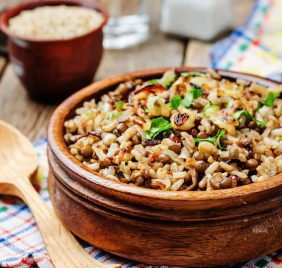The growing season has begun! Got a green thumb, but short on outdoor space? We’ve rounded up 10 herbs you can grow indoors–and ways to use them.
Basil
Health Benefits: Basil contains eugenol, an anti-inflammatory compound that helps block swelling.
Uses: Fresh basil is perfect for making pesto. Basil is also a natural cough suppressant, so make sure to chew a few leaves during your next cold or flu.
Growing Tips: Choose a container that’s at least 4” wide and has holes on the bottom for proper drainage. When the top of the plant reaches about 6” in height, it’s safe to start picking leaves.
Bay
Health Benefits: Bay leaves are a source of potassium, manganese and Vitamin C. Due to enzymes that aid in protein digestion, bay leaves have traditionally been used to treat bloating, reflux and indigestion.
Uses: Because of their concentrated health properties, dried bay leaves make for the perfect cup of tea. You might also try sprinkling fresh bay leaves into your next batch of stew or chili.
Growing Tips: Bay leaves require a pot at least 12” deep, and need plenty of sunshine. Remember to be patient: Bay is a slow grower!
Chives
Health Benefits: Chives are rich in vitamins A and C, helping to support your eyesight and immunity functions.
Uses: Celebrate #MeatlessMonday with grilled chickpea polenta cakes with chive oil and lemon. You might also try adding chopped chives to your ice cubes—their garlicky taste perfectly accents a glass of low-sodium tomato juice.
Growing Tips: Place this plant in a partially shaded area, and make sure to water regularly. Chives thrive in a pot that’s at least 6-8” deep.
Cilantro
Health Benefits: Cilantro is a good source of phytochemicals, including vitamin A, a powerful antioxidant that can help protect against heart disease, stroke and aging. Some studies show fresh leaves could be a natural antibiotic. To enjoy these benefits, eat cilantro when it’s fresh and vibrantly green.
Uses: Cilantro and lime make a classic pairing, as seen with this simple yet flavorful chicken dish.
Growing Tips: Begin by purchasing coriander seeds (coriander is cilantro in seed form). After planting the seeds, cover the container with plastic wrap until the seeds have germinated and are pushing against the plastic.
Mint
Health Benefits: Mint is often used to settle stomachaches and hangovers.
Uses: Mint is the perfect garnish for melons and berries. It also adds a great kick to this recipe for fettuccine with edamame, mint and pecorino.
Growing Tips: Mint plants tend to sprawl, so choose a large, deep pot at least 10” in diameter.
Oregano
Health Benefits: Oregano is truly a jack-of-all-trades. This flavorful powerhouse can be used to help ease heartburn, bloating, bronchitis, headaches, menstrual cramps and urinary tract infections (UTIs).
Uses: Spice up a boring chicken dish with this recipe for grilled chicken with roasted tomato and oregano salsa (and yes, pun intended).
Growing Tips: Oregano requires at least 6-8 hours of sunlight a day, so make sure to place this pant near a west-facing window.
Parsley
Health Benefits: A half cup of parsley contains more than 500 percent of your daily vitamin K needs, a nutrient essential for blood clotting following injury. This herb is also a natural diuretic, helping to reduce bloat.
Uses: Start the day right with a parsley, pineapple and banana smoothie.
Growing Tips: Parsley plants grow best with at least six to eight hours of sunlight per day. Water the herb enough so that soil is consistently moist to the touch (but never soggy).
Peppermint
Health Benefits: Peppermint is a popular remedy for nausea, vomiting, gas and diarrhea.
Uses: Settle digestion after a meal with a cup of peppermint tea (all you need are peppermint leaves and hot water!).
Growing Tips: Peppermint grows best with lots of sun. As peppermint plants tend to sprawl, you may consider transferring the plant outdoors once it reaches at least 4” in height.
Rosemary
Health Benefits: In addition to smelling great, rosemary contains carnosic acid, an antioxidant that may improve cholesterol levels.
Uses: For an added dose of Omega-3—a fatty acid shown to ward off depression, ADHD and Alzheimer’s—try this recipe for walnut and rosemary oven-friend chicken.
Growing Tips: Try planting seeds in soil made from a mixture of dirt and sand. Take care not to overwater this herb—water only when the top of the soil is dry to the touch.
Thyme
Health Benefits: Thyme is anti-septic, anti-viral and anti-fungal, making it ideal for treating skin infections, muscle pain and nail fungi.
Uses: Thyme serves as the perfect accent in this easy to make (and good for you) vegetarian side dish. You can also upgrade your condiment game by using the herb to make homemade mustard.
Growing Tips: A mixture of sand, potting soil, peat moss and perlite makes for an ideal soil base when planting thyme. Thyme also grows best with indirect sunlight.












